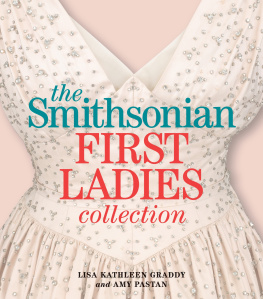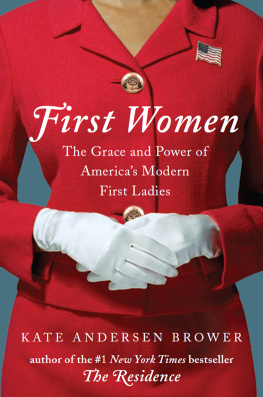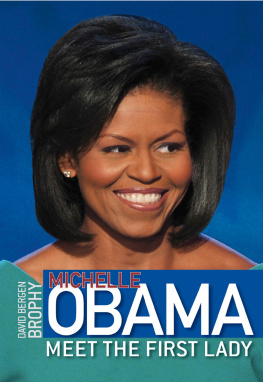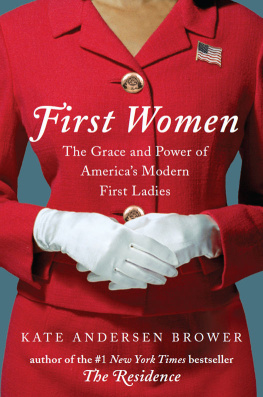First Ladies and American Women
Jill Abraham Hummer
First Ladies and American Women
IN POLITICS AND AT HOME
2017 by the University Press of Kansas
All rights reserved
Published by the University Press of Kansas (Lawrence, Kansas 66045), which was organized by the Kansas Board of Regents and is operated and funded by Emporia State University, Fort Hays State University, Kansas State University, Pittsburg State University, the University of Kansas, and Wichita State University
Library of Congress Cataloging-in-Publication Data
Names: Hummer, Jill Abraham, author
Title: First ladies and American women: in politics and at home / Jill Abraham Hummer
Description: Lawrence, Kansas: University Press of Kansas, [2017] | Includes bibliographical references and index
Identifiers: LCCN 2016051183
ISBN 9780700623808 (hardback: acid free paper)
ISBN 9780700623815 (ebook)
Subjects: LCSH: Presidents spousesUnited StatesHistory20th century. | Presidents spousesUnited StatesHistory21st century. | Presidents spousesUnited StatesBiography. | Presidents spousesFamily relationshipsUnited StatesHistory. | WomenPolitical activityUnited StatesHistory. | Sex roleUnited StatesHistory. | United StatesPolitics and government19291933. | United StatesPolitics and government19331945. | United StatesPolitics and government19451989. | United StatesPolitics and government1989 | BISAC: HISTORY / United States / 20th Century. | HISTORY / United States / 21st Century. | POLITICAL SCIENCE / Government / Executive Branch.
Classification: LCC E176.2 H86 2017 | DDC
320.082/0973dc23
LC record available at https://lccn.loc.gov/2016051183.
British Library Cataloguing-in-Publication Data is available.
Printed in the United States of America
10987654321
The paper used in this publication is recycled and contains 30 percent postconsumer waste. It is acid free and meets the minimum requirements of the American National Standard for Permanence of Paper for Printed Library Materials Z39.48-1992
This book is dedicated to my parents,
Tom and Linda Abraham
Acknowledgments
I am indebted to family, friends, and colleagues, who provided me support and encouragement in writing this book. I gathered the evidence presented in this volume at a series of presidential libraries, whose staffs were always responsive to my many requests. Thanks go to the archivists at the Herbert Hoover Library, Harry S. Truman Library, Dwight D. Eisenhower Library, John F. Kennedy Library, Lyndon B. Johnson Library, Richard Nixon Presidential Materials, Gerald R. Ford Library, Jimmy Carter Library, Ronald Reagan Library, and George Bush Library. Thanks also to the Wilson College librarians, who went to great lengths to acquire materials.
The research in this volume was supported by generous grants from the Herbert Hoover Foundation, Franklin and Eleanor Roosevelt Institute, Harry S. Truman Library Institute, John F. Kennedy Library Foundation, Lyndon B. Johnson Foundation, and Gerald R. Ford Foundation. These grants allowed me to collect materials at their respective libraries. The White House Historical Association also provided funds to defray the costs of research. A research stipend from Wilson College funded the collection of photographs in this volume, as well as the research of my student Christina Gonzalez, who gathered materials for me at the Ronald Reagan Library. A sabbatical leave from Wilson College helped to bring this project to a successful conclusion, and I am grateful to my colleague Kay Ackerman and to Dean Elissa Heil for making that possible.
This volume is the outgrowth of my work as a graduate student at the University of Virginia. Thanks are due to Steve Rhoads, Holly Shulman, and the late James Sterling Young of the University of Virginia and to MaryAnne Borrelli of Connecticut College, who provided mentorship on that initial project. I am also grateful to the editors and staff at the University Press of Kansas, as well as anonymous reviewers, for believing in this project and bringing it to fruition.
Credit especially goes to my family. To my husband, Josh, for his unrelenting commitment to me and support for my project. This book, my first, is dedicated to my parents, in gratitude for my education. To my four children, Scarlett, Abe, Pierce, and Iris, who daily challenged me, Did you write your words today, Mama? I share this accomplishment with all of you. Thanks also to many individuals who supported my family while I wrote my words.
I have no doubt that mistakes, gaps, and misinterpretations cloud this work. It is imperfect as humans are imperfect. And so I urge readers to grant mercy and consider, Where is the wise man? Where is the scholar? Where is the philosopher of this age? Has not God made foolish the wisdom of this world? For since in the wisdom of God the world through its wisdom did not know him, God was pleased through the foolishness of what was preached to save those who believe (1 Corinthians 1:2021).
Introduction
I n April 2011, Michelle Obama attended a baby shower for forty pregnant military wives at Camp Lejeune, North Carolina. She came bearing a basket filled with pink and blue White House blankets. She had taken up a gift drive, placing donation boxes all over the East Wing and West Wing. The shower was part of her Joining Forces initiative to ease burdens on military families. Four decades earlier, Pat Nixon traveled to Africa as the nations official representative. She conferred with heads of state, joined African women in a traditional tribal dance, and visited a school for modern homemaking. Nearly four decades before that, as the country sank deeper into the Great Depression, Lou Hoover took to the airwaves and told women how they could play a part in unemployment relief. She praised American women for making it possible that a child might go to school sufficiently fed and clothed and that a high school girl might finish her course in stenography and bookkeeping.
American first ladies have acted. They have acted in multiple ways and against shifting backdrops. On her Africa trip, Pat Nixon, after a sleepless nine-hour flight and a frantic twelve-hour day of activities, declared that being first lady was the hardest unpaid job in the world. The first ladyship is a job. It is a peculiar job. Its occupants have worked. They have done duties and performed roles. However, there are no federal guidelines telling first ladies how they must act. They are unelected, having attained their positions by virtue of marriage. Though they have worked, American first ladies have not drawn salaries. Yet, despite the fuzzy role definition and questionable basis of authority, first ladies have acted. This book explores what they have done and why.
First ladies have been intimately connected to American womanhood. A sweeping glance across history reveals this much. The actions and public evaluations of first ladies have been affiliated with womens roles, rights, and responsibilities. These ties are at once intriguing and bewildering. But it is nevertheless clear that the story of first ladies has been linked to the story of women in America. The two cannot be understood apart from each other. This book interweaves these two stories into a single narrative beginning with Lou Hoover and ending with Michelle Obama. Through this knitted narrative, the first ladies actions and the forces behind them are illuminated and unveiled.









